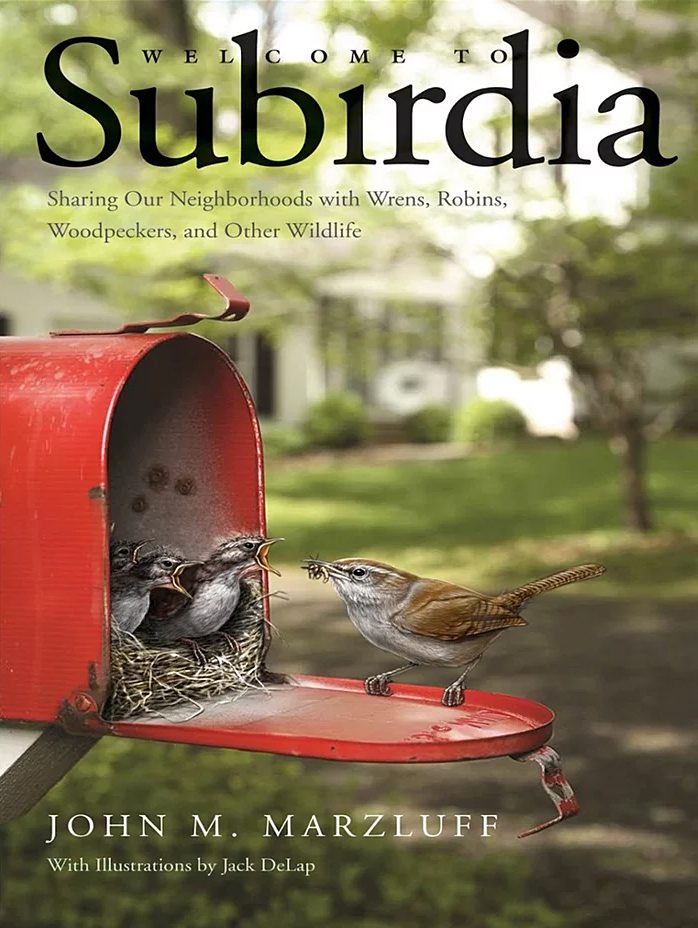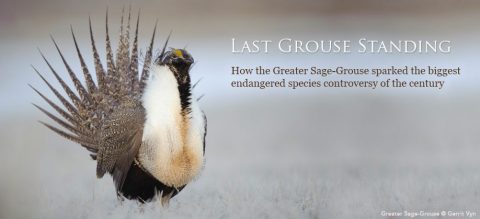Book Review: Welcome to Subirdia, by John Marzluff
Reviewed by Stephen J. Bodio
From the Spring 2015 issue of Living Bird magazine.
April 14, 2015
For the cover of the new edition of my book On the Edge of the Wild, Russian artist Vadim Gorbatov painted a striking image of a yellow-eyed Northern Goshawk attacking a crow. But the scene is not one of wilderness; in its background is Vadim’s apartment in Moscow. Just one of the amazing observations in John Marzluff ’s groundbreaking and entertaining new book, Welcome to Subirdia, is that in Europe, goshawks are more common in cities than in the countryside.
Subirdia’s startling thesis is that suburbs not only hold a surprising variety of creatures, they often increase diversity. Although some species may not do well, the mosaic of edges and small refuges that make up this fractal habitat provides new opportunities for native creatures, not to mention species that have so escaped their natural bonds that they occur in virtually every city in the world.
Marzluff ’s “Exploiters” include five cosmopolitans: Canada Goose, European Starling, House Sparrow, Mallard, and Rock Pigeon, and a couple of Americans, the House Finch and American Crow. “Adapters” are native birds that tolerate or exploit manmade niches; only “Avoiders” suffer. How these various categories interact with our changing landscapes is the subject of this book.
God or the devil is in the details. Who would have thought that the Pileated Woodpecker, in my New England youth a shy deep-forest denizen, would now live happily in Seattle? One might think the same of Accipitrine hawks, but the Cooper’s Hawk may now be the most common urban raptor in the world. The incongruities pass on down the line. Although the hawk’s favorite prey species do not do well close to Cooper’s Hawk nests, they do better in the predator’s larger territory than those outside; Cooper’s Hawks kill jays, squirrels, and other egg predators.
Cities affect behavior. I have noticed blackbirds hanging around the WalMart in Socorro, New Mexico. Marzluff has studied them in Seattle, and not only do they exploit a similar niche there, they don’t show up until 15 minutes before opening time! Cities are also influencing the physical evolution and genes of birds. Cliff Swallow populations that nest under freeway bridges are being measurably selected for longer, thinner wings, for more maneuverability. The island nature of cities means that the odd pressures of island biogeography apply; different cities now have visibly different local races of House Sparrow, which have evolved over fewer than 50 years. Real evo-geeks can even find some rare instances of sympatric speciation (with hybridization!) caught in the process of dividing.
Some of the most fascinating and horrifying facts in this book are statistics. We use half a million to nearly one and a quarter million tons of birdseed in feeders every year. This costs $3.5 billion, about what we give in aid to feed people in Africa. Such numbers mean that some relatively uncommon species of bird such as the Pinyon Jay are now laying more eggs and expanding their numbers in places where they are fed. A most appalling statistic is the number of birds killed by domestic cats in the Lower 48 states: 1.4 to 3.7 billion a year. So you definitely shouldn’t let your cat out.
The book is beautifully illustrated by Jack DeLap and is full of Marzluff ’s patented mix of hard science, anecdote, and humor. At the end he gives us nine commandments for living with our nonhuman neighbors and concludes with a happy 10th: “Enjoy and bond with nature where you live, work, and play!”

All About Birds
is a free resource
Available for everyone,
funded by donors like you
American Kestrel by Blair Dudeck / Macaulay Library



